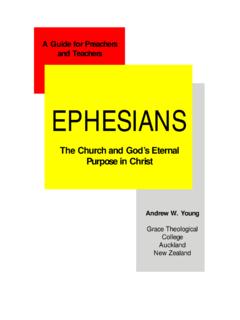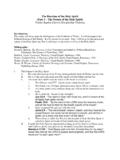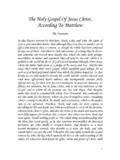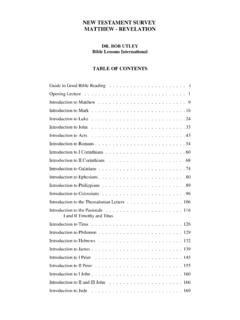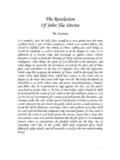Transcription of Worship in the Early Church - Grace Theological College
1 1 Worship in the Early Church by S. Bracefield How did the Church of the Early centuries (before Constantine) conduct its meetings on the Lord s Day? Can we learn anything from this to help us in our Worship services today? Introduction A Time of Change In the age of the Early Church ( 30 312 AD) the way Worship was conducted underwent significant development.
2 This development was greatly influenced by the Church s adapting to the following changes: - the Church s spread to embrace many and diverse cultures - the Church s response to heresies that arose - the rise of episcopacy There are difficulties in piecing together how and when changes occurred, and how universal they were. The New Testament doesn t give a complete description of Worship and later material is sketchy and may contain inaccuracies. Nevertheless it is possible to get a general idea of patterns and developments1.
3 1. Worship in the days of the Apostles (NT: Acts and Epistles2) Jewish beginnings As mentioned above the first Christians were Jews and lived in Palestine. They understood Jesus to be the Messiah hoped for by the Jewish people so did not initially at least see themselves to be a movement separate from Judaism. They continued to Worship in the temple and synagogue along with their fellow countrymen, living as good Jews, keeping the law. Christians in Palestine did not cease worshipping in the synagogue and temple until they were barred from synagogues following the destruction of the temple in 70AD.
4 Even many of those forced out of Palestine by persecution prior to this time were able to join a local 1 Ralph P. Martin, Worship and Liturgy, in Dictionary of the Later NT, Martin and Davids, Eds., (Downers Grove; IVP,1997), 1225. He cautions against harmonising: ignoring the likelihood of regional variation, and assuming a linear development to reconstruct where there is no data. 2 Names in brackets after each major heading are the most important primary sources drawn on by authors referenced in this essay 2 synagogue as synagogues existed in most major towns and cities in the Roman Empire.
5 It is helpful here to give a description of synagogue Worship because besides being an integral part of Early Christian Worship , when Christianity eventually broke from Judaism and in the Gentile churches founded by Paul the pattern of synagogue Worship was largely carried over into Christian Worship services. Jewish Synagogue Service 3 Open with prayer4 (Shema) 2 benedictions reading of 10 Commandments (by a reader) Amen response of congregation 18 prayers and benedictions (by a reader) Amen response of congregation lesson from law and lesson from prophets (read in Hebrew) homily in vernacular benediction and Amen Other important details.
6 - any Jew of age could read the lesson, offer prayer or address the congregation - the leadership consisted of president, elders (equal in rank), reader, interpreter, clerks, sexton (for humbler mechanical services) and deacons for collection of alms - synagogues corresponded between each other - services were held on Sabbath, Monday and Thursday. Hours of prayer were 9, 12 and 3 - men and women were divided by a low wall or screen - during prayer people stood with faces to Jerusalem It is easy to see how the Early Christians remained in Judaism so long.
7 The synagogue centred around the Jewish Scriptures and the Worship of Yahweh. Also because any man of age was able to pray, read and speak it was the ideal place to speak about Jesus and show how the Scriptures pointed to him. Separation from Judaism eventually happened because their unbelieving countrymen forced them out. Differences between Christian Jews and Jews Christians worshipped Jesus as God alongside the Father. Christians had received the Spirit in a way the Jews hadn t which brought illumination: they had a different understanding of the way of salvation and rejoiced that the promises had been fulfilled and the Messiah had come, and joy: their Worship was characterised by exultant praise5.
8 Early Christian Practises Distinct from Judaism Alongside their Judaism the Early Christians also had some of their own practises. They had their own sacraments: baptism and the Lord s Supper 3 Philip Schaff History of the Christian Church , 212,213 4 prayers and songs were chiefly from the psalter: the first liturgy and hymnbook 5 Ralph P. Martin, Worship and Liturgy, in Dictionary of the Later NT, Martin and Davids, Eds., (Downers Grove; IVP,1997), 1228 3 (which had been instituted by Christ), and their own meetings as described by Acts 2:42-47.
9 They met daily in the temple and in houses (although it seems unlikely that this was sustained) continuing steadfastly in the apostle s doctrine, fellowship, in the breaking of bread6, prayers7 Meetings were characterised by simplicity and gladness (v47). Early Gentile Christianity While Paul first spoke at the local synagogue when he came to a new area, antagonism led to the churches he founded being completely separated from Judaism. Most of the new converts were also Gentiles rather than Jews.
10 Paul set a pattern for the churches he established based on the pattern of Jewish synagogue Worship but divested of its Jewishness as set out in the table below8. Many of these churches were well established and exerting great influence by the time Jewish Christians were expelled from the synagogue. Christianity became a global movement based on Paul s model and Christianity within Judaism died out. Judaism Christianity Worship (holy) day 7th day (creation) 1st day (resurrection) Sacraments Circumcision, Passover Baptism, Lord s Supper Festivals Several including Passover & Pentecost Passover & Pentecost (but modified to celebrate their fulfilment.)
